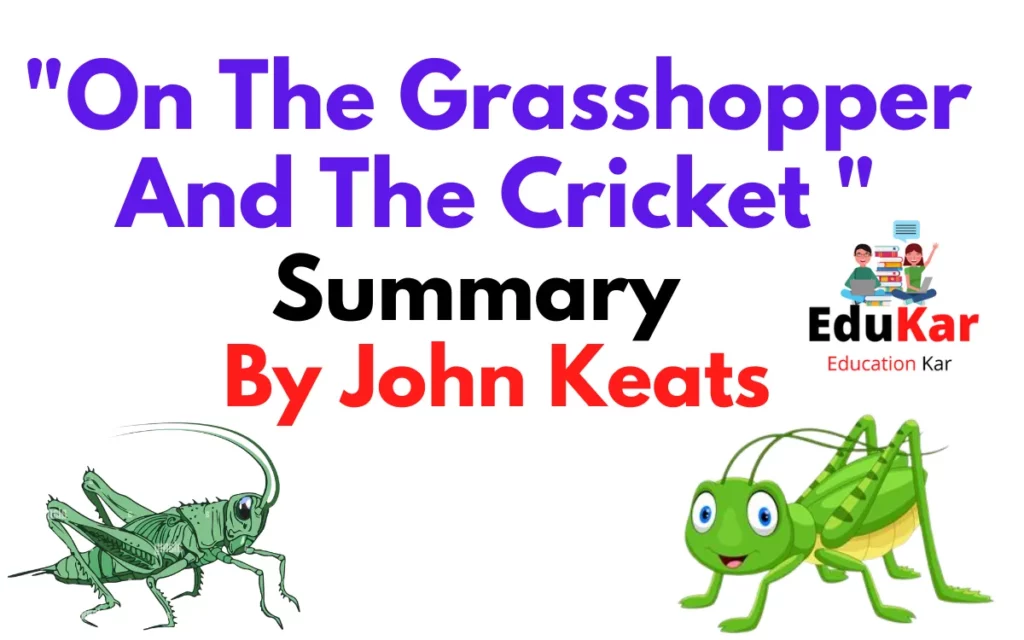Contents
- 1 Introduction
- 2 English Summary – “The Poetry Of Earth”
- 3 The Poetry of Earth important MCQ
- 4 About The Author
- 5 Conclusion – “The Poetry Of Earth”
- 6 FAQs for “The Poetry Of Earth” By John Keats
- 6.1 What is “The Poetry of Earth” by John Keats?
- 6.2 What are the main themes in “The Poetry of Earth”?
- 6.3 What is the significance of the title “The Poetry of Earth”?
- 6.4 How does Keats use imagery and language in “The Poetry of Earth”?
- 6.5 Why is John Keats considered one of the greatest poets of the Romantic era?
| Name | The Poetry Of Earth |
|---|---|
| Subject | English |
| Class | 12th |
| Board | WB |
| Type | Poem |
| Author | John Keats |

Introduction
“The Poetry of Earth” is a famous poem written by John Keats, a prominent English Romantic poet. The poem was first published in 1820 in Keats’s collection of poems, “Endymion.” The poem is a reflection on the beauty and power of nature and its ability to inspire poetry and artistic creation. It is a celebration of the beauty and power of nature and its ability to inspire poetry and artistic creation through vivid imagery and metaphors, as well as personification. Keats also highlights how this poetry of earth is a poetry of immortality, as it will always continue to inspire future generations.
English Summary – “The Poetry Of Earth”
The poem begins with Keats describing the different elements of nature that inspire him to write poetry. He talks about the “songs of spring” that fill the air, the “sapphire queen” of the sky, and the “green-robed senators” of the forest. He also mentions the “fairies’ lamps” that light up the night sky and the “cloud-capp’d towers” that are illuminated by the setting sun.
The poem goes on to describe the different seasons and how they each inspire a different type of poetry. In the spring, Keats writes about the “soft names” and “breezy call” of the new growth and the “young buds” that bloom on the trees. In the summer, he writes about the “blossoms” and “ripened fruit” that are in abundance. In the fall, he writes about the “brown leaves” and “frosty breath” of the dying trees. In the winter, he writes about the “bare ruined choirs” and “frosty breath” of the dormant trees.
Throughout the poem, Keats uses vivid imagery and metaphors to convey the beauty and power of nature. He also uses personification to give life and character to the elements of nature, such as the “green-robed senators” of the forest.
The poem ends with Keats saying that the “poetry of earth” is never-ending and always inspiring. He writes that the beauty of nature will always inspire poets and artists to create, even after he is gone. He also states that the “poetry of earth” is the “poetry of immortality” as it will always inspire future generations of poets and artists.
Overall, The Poetry of Earth is a powerful and beautiful poem that celebrates the beauty and power of nature and its ability to inspire poetry and artistic creation. Keats’s vivid imagery and metaphors, as well as his use of personification, make the poem come alive, making it a true masterpiece of English Romantic poetry.
The Poetry of Earth important MCQ
About The Author
John Keats was an English Romantic poet, who is considered one of the greatest poets in the English language. He was born on October 31, 1795, in London, England, and died on February 23, 1821, at the young age of 25. Despite his short life, Keats left a lasting legacy through his poetry, which is known for its vivid imagery, powerful emotions, and exploration of the human condition.
Conclusion – “The Poetry Of Earth”
In conclusion, “The Poetry of Earth” is a powerful and beautiful poem that celebrates the beauty and power of nature and its ability to inspire poetry and artistic creation. Keats’s vivid imagery and metaphors, as well as his use of personification, make the poem come alive, making it a true masterpiece of English Romantic poetry. The poem ends with Keats expressing that the “poetry of earth” is never-ending and always inspiring. He writes that the beauty of nature will always inspire poets and artists to create, even after he is gone. He also states that the “poetry of earth” is the “poetry of immortality” as it will always inspire future generations of poets and artists. Thus the poem presents nature as a source of inspiration and eternal beauty for poets and artists as well as for people in general.
FAQs for “The Poetry Of Earth” By John Keats
What is “The Poetry of Earth” by John Keats?
“The Poetry of Earth” is a collection of poetry by John Keats, published posthumously in 1848. The collection includes some of his most well-known poems, such as “Ode to a Nightingale” and “To Autumn.”
What are the main themes in “The Poetry of Earth”?
The main themes in “The Poetry of Earth” include nature, beauty, mortality, and the passage of time. Keats’ poetry often explores the fleeting nature of beauty and the inevitability of death.
What is the significance of the title “The Poetry of Earth”?
The title “The Poetry of Earth” reflects Keats’ belief that poetry should be rooted in the physical world and draw inspiration from nature. In his poetry, he sought to elevate the beauty of the natural world and to explore the deeper truths of existence.
How does Keats use imagery and language in “The Poetry of Earth”?
Keats uses vivid imagery and rich, evocative language in his poetry. He often uses classical allusions and literary devices such as metaphor and personification to create a sense of beauty and timelessness in his work.
Why is John Keats considered one of the greatest poets of the Romantic era?
John Keats is considered one of the greatest poets of the Romantic era because of his vivid imagery, evocative language, and exploration of themes such as nature, beauty, and mortality. His poetry is widely regarded as some of the most beautiful and moving of the Romantic era, and continues to be widely read and admired today.


![The Poetry of Earth Question Answer 2023 [Short & Long] The Poetry of Earth Question Answer](https://edukar.org/wp-content/uploads/2023/01/The-Poetry-of-Earth-Question-Answer-1024x640.webp)




![Asleep in the Valley Questions and Answers 2023 [Class 12-English] Asleep in the Valley Questions and Answers](https://edukar.org/wp-content/uploads/2022/12/Asleep-in-the-Valley-Questions-and-Answers-1024x640.webp)







